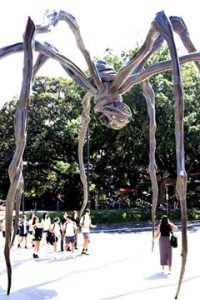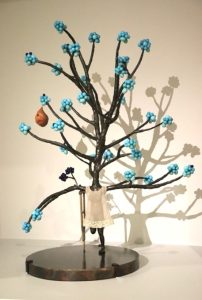Spiderwoman finally leaving town

By Frances Goold
Louise Bourgeois: Has the Day Invaded the Night or Has the Night Invaded the Day?
25 November 2023 – 28 April 2024*
Art Gallery of New South Wales
North Building
Lower level 2
Lower level 4, The Tank
Hovering resplendent over the forecourt of the old sandstone building (now the South Building) is Louise Bourgeois’s giant spider, Maman. This surreal, sci-fi giant sculpture provides a paradoxically protective, almost balletic entrée to an astonishing exhibition of sculptures, paintings, sewn works, and drawings by the late French American artist, scheduled to close at the end of this month after a five-month run.
Smaller spiders of similar grace robust beauty are to be found elsewhere: in The Tank, located on Level 4 of the new North Building, where the ‘Night’ section of the conceptually divided show is exhibited, and on Level 2, where works associated with ‘Day’ are exhibited in rooms of almost Zen quietude.

Louise Bourgeois, Maman, Art Gallery of NSW
But it is Maman which theatrically announces the first solo exhibition to be held at the revamped and extended art museum, Sydney Modern, artfully linking the two buildings following a long gestation and difficult birth – much like Bourgeois’s own.
Growing up in France in a family of tapestry restorers she is said to have learned to use a needle and thread when other kids her age were learning to use a knife and fork. But it was also a dysfunctional and disturbed household during the post-WW1 years until she found refuge at the Sorbonne at nineteen, attracted to mathematics and geometry as subjects valued for their stability and “rules nobody could change”.
Upon her mother’s death in 1932 Bourgeois switched her intellectual focus to art, attending artist studios and academies until, after graduating from the Sorbonne in 1935, she opened her own gallery in Paris where she met her future husband, the art historian Robert Goldberg. They relocated to New York in 1938, where they raised a family, she resumed her studies, and both re-established their respective careers.
There is no way to sum up the intense creativity of Louise Bourgeois other than to urge you to see some of her vast legacy before it disappears. Given the harrowing and traumatic events of the past week in Sydney, its imminent closure and departure is a fittingly sober exit from the building of a body of work but not the spirit of an artist whose unique practice sought to express and transform her own personal emotional trauma and to inspire others to do the same.
With so little time remaining there are, however, one or two fragile pathways to comprehending some of Bourgeois’s psychological and aesthetic concerns and convictions. One poignant example is to be found amongst her ‘Day’ collection on Level 2, where the viewer can slow down and peruse the gentle flow of her exquisite ‘samplers’, annotated paintings, and drawings.
Here Bourgeois tells the story of a boy caught inside a terrible fight between his parents:
“He kept alive. And he went over to the closet and brought back a broom and he started cleaning. At that point something broke inside of me and I started crying and you know, I never cry. Something broke inside.”
She describes how making art is about a moment when is performed “a symbolic action…you begin to work on the sculpture” as a means of redirecting and channelling the feeling state into something else, something constructive and transformative. She adds:
“… there are many symbolic actions of course, the different qualities are everything. The symbolic action can take many many forms. Some people will become perfectionists in whatever they are doing or they can write, they can write a story or they can work on the house.”
In the next picture she concludes, “We are talking about sublimation and the gift of sublimation.”

Topiary 4 1999
How timely are the artist’s reminders of how we can somehow, sometime, begin to bear the unbearable and find other ways to express our feelings and emotions when words fail – a methodology now standard practice in art therapeutic work with distressed and traumatised children incapable of putting their overwhelming experiences into words.
In its other more searing and confronting aspects it’s an adult show – both visually and conceptually – but there is much to surprise and intrigue the young if only for its rambling, unpredictable scale, and the myriad feelings evoked in a place of safety. The architectural and institutional robustness of the buildings in which the works are housed allows for moments of deep contemplation of a particular work to a point of intimacy, as if in private conversation with the artist; in that moment one may be struck by a disarming sense that the artist is in direct communication with you as viewer. And there is something oddly comforting about this, leaving even her monsters tenderised and approachable. Perhaps in this lies both the particularity and universality of Louise Bourgeois’ special magic.
This is an important show, spanning seventy years of a disciplined, fiercely independent artist’s creative life, which began in France in 1911 and ended in New York in 2010. It spans the productive years of a compulsive yet contemplative artist whose artmaking was inextricably entwined with family trauma and random tragedy, that ultimately made its way from ‘darkness’ to ‘light’ through the sheer persistence of her uniquely gifted and unorthodox expression.
By our glistening autumn harbour is the final week of a big show by a tiny woman who has not simply created monumental art but, in an abiding, maternal, tetchy, spidery way, produced both great and small works that make profound and moving statements about what it means to be vulnerable and, it follows, what it means to be human.
* * * * *
*For this final week or so a special 2-for-1 offer is available for visits after 5pm on Wednesdays 17 and 24 April during Art After Hours when the whole Gallery is open until 10pm, and after 5pm on Friday 26 to Sunday 28 April when the exhibition and shop will remain open until 10pm for the final weekend of Louise Bourgeois, with curator tours and a pop-up bar on the Friday and Saturday nights.
Like what we do at The AIMN?
You’ll like it even more knowing that your donation will help us to keep up the good fight.
Chuck in a few bucks and see just how far it goes!
Your contribution to help with the running costs of this site will be gratefully accepted.
You can donate through PayPal or credit card via the button below, or donate via bank transfer: BSB: 062500; A/c no: 10495969









